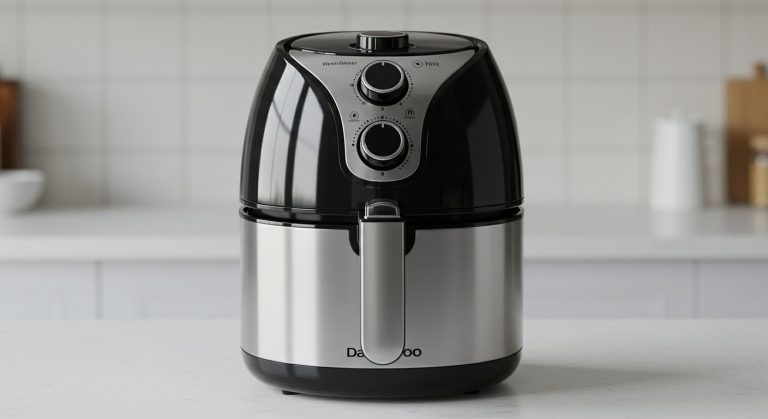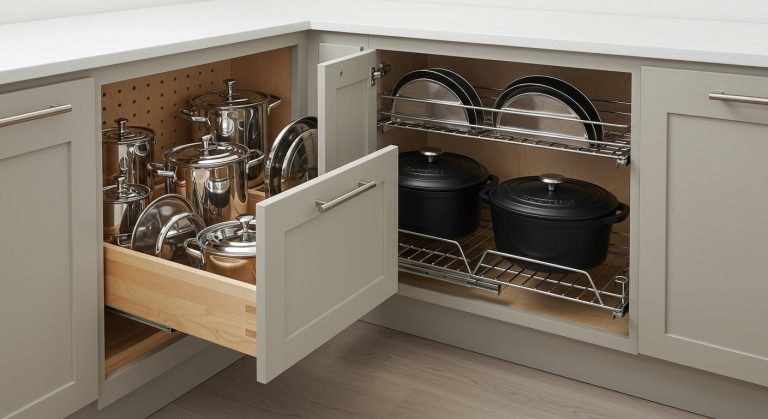Frying Pan Buying Guide: Perfectly Explained
Key Takeaways
Choosing the right frying pan can be surprisingly complex. This guide will walk you through the different types of frying pans, materials, features, and considerations so you can make an informed decision and find the perfect frying pan for your cooking needs. From searing steaks to flipping pancakes, the right pan makes all the difference. Let’s dive in!
Understanding Frying Pan Materials
The material of your frying pan significantly impacts its performance, durability, and price. Here’s a breakdown of the most common options:
Stainless Steel
Stainless steel frying pans are known for their durability and versatility. They heat up relatively quickly and evenly (especially when constructed with a multi-ply base incorporating aluminum or copper), and they’re oven-safe, dishwasher-safe, and resistant to rust. However, stainless steel is not inherently non-stick, so you’ll need to use enough oil or butter to prevent food from sticking. A good quality stainless steel frying pan is a staple in any kitchen.
Non-Stick (Teflon, Ceramic, etc.)
Non-stick frying pans are incredibly convenient for cooking delicate foods like eggs and fish. They require little to no oil, making them a healthier option. These pans are typically coated with Teflon (PTFE) or ceramic. Teflon is highly effective but can be damaged at very high temperatures. Ceramic coatings are generally more eco-friendly and can withstand higher heat, but may not be as durable as Teflon over time. When using non-stick cookware, avoid using metal utensils that can scratch the surface.
Cast Iron
Cast iron frying pans are prized for their exceptional heat retention and even heating. They can withstand extremely high temperatures, making them ideal for searing and frying. Cast iron pans can be used on the stovetop, in the oven, and even over a campfire. The catch? They require seasoning to prevent rusting and food from sticking. Regular seasoning (coating with oil and baking) builds up a non-stick patina over time. They are also heavy and require some extra care to maintain, but a well-seasoned cast iron frying pan can last a lifetime.
Carbon Steel
Carbon steel frying pans share many characteristics with cast iron. They are durable, heat up quickly, and can be used at high temperatures. Carbon steel is lighter than cast iron, making it easier to handle. Like cast iron, carbon steel requires seasoning to prevent rust and sticking. Many professional chefs prefer carbon steel for its responsiveness and versatility.
Copper
Copper frying pans are renowned for their exceptional heat conductivity, allowing for precise temperature control. They heat up and cool down quickly, making them ideal for delicate sauces and dishes that require rapid temperature changes. Copper pans are also beautiful and can add a touch of elegance to your kitchen. However, they are expensive and require special care to maintain their shine. They are also typically lined with stainless steel as copper can react with some foods.
Choosing the Right Size and Shape
The size and shape of your frying pan will depend on the types of dishes you typically cook and the number of people you usually cook for.
Size Matters
Frying pans typically range in size from 8 inches to 14 inches. An 8-inch pan is suitable for cooking single servings or small portions. A 10-inch or 12-inch pan is more versatile and can accommodate larger meals for families or entertaining. A 14-inch pan is ideal for cooking large batches or searing large cuts of meat.
Shape Considerations
Most frying pans are round, but you can also find square or rectangular pans. Round pans are versatile and suitable for a wide range of cooking tasks. Square or rectangular pans provide more surface area, making them ideal for cooking multiple items at once, such as pancakes or grilled cheese sandwiches.
Features to Look For
Beyond material and size, several features can enhance the performance and usability of your frying pan.
Handle Material and Design
The handle should be comfortable to grip and stay cool during cooking. Common handle materials include stainless steel, plastic, and wood. Stainless steel handles are durable and oven-safe, but they can get hot. Plastic handles stay cool but may not be as durable as stainless steel. Wood handles provide a comfortable grip but are not oven-safe. Consider the ergonomics of the handle and how it feels in your hand. Some handles are riveted for added stability, while others are welded.
Oven-Safe Temperature
If you plan to use your frying pan in the oven, check the oven-safe temperature rating. Stainless steel and cast iron pans are typically oven-safe to high temperatures, while non-stick pans may have lower temperature limits. Always check the manufacturer’s instructions before placing a frying pan in the oven.
Lids
A lid can be a valuable addition to your frying pan. It helps trap heat and moisture, making it ideal for simmering, braising, and steaming. Lids are typically made of glass or metal. Glass lids allow you to monitor the cooking process without lifting the lid, while metal lids are more durable.
Induction Compatibility
If you have an induction cooktop, make sure your frying pan is induction-compatible. Induction cooktops require cookware with a magnetic base, such as stainless steel or cast iron. Many modern frying pans are designed to work with all types of cooktops, but it’s always a good idea to check the manufacturer’s specifications.
Caring for Your Frying Pan
Proper care and maintenance will extend the life of your frying pan and ensure optimal performance.
Cleaning Tips
Follow the manufacturer’s instructions for cleaning your frying pan. Stainless steel and cast iron pans can typically be washed in the dishwasher, but non-stick pans should be hand-washed to prevent damage to the coating. Use a non-abrasive sponge and mild soap to clean your frying pan. Avoid using steel wool or harsh chemicals.
Seasoning (for Cast Iron and Carbon Steel)
To season a cast iron or carbon steel frying pan, coat it with a thin layer of oil and bake it in the oven at a high temperature (around 400°F) for an hour. This process creates a non-stick patina that protects the pan from rust and prevents food from sticking. Repeat this process regularly to maintain the seasoning.
Storage
Store your frying pans in a dry place to prevent rust. If stacking pans, use pan protectors to prevent scratches, especially on non-stick surfaces. Hanging your frying pans is another great option that saves space and prevents damage.
Price Considerations
Frying pans range in price from budget-friendly to high-end. The price will depend on the material, construction, and features. Generally, stainless steel, cast iron, and carbon steel are a mid-range option, while copper frying pans are at the higher end of the price spectrum. Non-stick pans can vary widely in price depending on the quality of the coating.
Choosing the Best Frying Pan for Your Needs
Ultimately, the best frying pan for you will depend on your cooking style, budget, and preferences. Consider the types of dishes you typically cook, the number of people you usually cook for, and the features that are most important to you. Don’t be afraid to invest in a good-quality frying pan that will last for years to come.
Frequently Asked Questions (FAQs)
What is the best material for a frying pan?
There’s no single “best” material – it depends on your needs! Stainless steel is durable and versatile, non-stick is convenient for delicate foods, cast iron is great for high-heat searing, and copper offers exceptional heat control. Consider your cooking style to choose the right material.
How often should I season my cast iron frying pan?
Ideally, you should season your cast iron pan after each use, especially if you’ve cooked acidic foods. If you rarely use your pan, season it at least once a month to prevent rust. A well-maintained seasoning is key to a non-stick cast iron.
Are non-stick frying pans safe to use?
Yes, modern non-stick frying pans are generally safe to use. However, it’s important to follow the manufacturer’s instructions and avoid overheating them. Older Teflon pans contained PFOA, a potentially harmful chemical, but PFOA has been phased out of production. Ceramic coatings are also a safe alternative to Teflon.
Can I put my frying pan in the dishwasher?
It depends on the material and the manufacturer’s instructions. Stainless steel and cast iron pans are typically dishwasher-safe, but non-stick pans should be hand-washed to prevent damage to the coating. Always check the manufacturer’s recommendations before putting your frying pan in the dishwasher.



